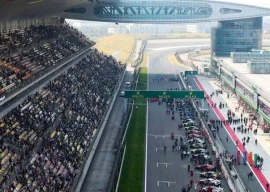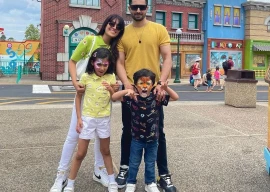
Cradled by lofty mountains, Muzaffarabad sits at the confluence on Neelum and Jehlum rivers.
The city was the site of the epicentre of the 2005 earthquake, which destroyed almost half of the city’s structures, including most of the official buildings.
350-year-old fort in ruins
On a peninsular protrusion of land, surrounded by the Neelum River, sits the Red Fort, built by Sultan Muzaffar Khan, founder of the city of Muzaffarabad, in 1646.
When the earthquake rocked the city, the 350-year-old fort was badly damaged, its walls punctured with large gaping holes.
There are no open spaces in Muzaffarabad. One is this fort, which is in real poor condition, while the other fort has been taken over by the military. The government should promote such archaeological sites to attract local and international tourism but look at it ... it is now a ruin.
Shahzad Mir, 29, local resident
It is about the priority the government has for allocating funds, and for them these are not priorities since there is so much reconstruction to be done of basic infrastructure.
Economic growth and sustainability can be achieved through promoting local tourism industry but with the government in a financial crunch, it may take forever to rehabilitate art, culture and heritage of Kashmir that was lost in the earthquake.
Dr Shehla Waqar, secretary for the Department of Archaeology and Tourism of Azad Jammu and Kashmir
‘Chop the artisan’s hands’
Khwaja Meer Farooq produced Kashmiri-designed, carved wood furniture at a shop in Muzaffarabad. Post earthquake, he runs a real estate business at the same premises, with hangings of intricately crafted furniture on the walls being the only remnants of his past profession.
After the destruction, I could not afford to rebuild what I had lost at the shop. Also, our handicraftsmen were expecting to receive payment for our merchandise that was kept at government managed emporium but six years later we are still waiting for it. It’s been a year since we asked the courts to provide relief but the government is resorting to delay tactics and never shows up at hearings. They have no understanding for the value of heritage. Might as well chop our hands off, as they are of no use since the earthquake.
Living on the edge
I don’t think my house should be on this mountain slope, it’s not safe. But then I am thankful that I got something from the authorities. If they did not have give us this shelter, what could we do?
Hukum Din, 42, lives in a two-room house in Makri Bela, an area declared a “red zone” by geological experts due to its proximity to the quake epicenter. Donated by Saudi authorities, the shelters have been made permanent by adding concrete rooms. Din’s house has one wall next to the mountain slope, the other jutting out perilously over the edge.
The code of conduct for earthquake construction is being violated not just by the rural population but the government itself. The international donors constructed some infrastructure themselves and it was done properly but the locals have been ignoring the rules. Even the construction material used is substandard. Demarcation of the fault line in Muzaffarabad has not happened and reconstruction on it continues to flourish.
Shafique Qureshi, a geologist working in this area with the Asian Development Bank.
Rs75,000 were provided to people to relocate from dangerous red zones, since these areas are not only earthquake-prone but can be devastated in flash floods and heavy rain. The city, however, does not have the capacity. It is overpopulated and there is not much we can do about that, I recommend they move to suburban areas of Muzaffarabad. Working with ERRA, we have tried to rehabilitate the population but we have achieved less than 50% of what needs to be done.
Dr Ghulam Haider Kazmi, a consultant for the United Nations Development Programme and affiliated with Erra, fears that people will continue to live in red zone areas for many years to come.
Paper-mache artist, no more
I had a workshop and a small training center where I taught paper-mache to anyone who came to learn. The building collapsed in the earthquake and with it went my livelihood.
I came to Muzaffarabad in the 90’s, during the rise of armed struggle in Indian Kashmir. At first I wanted to pick up arms and go back, but I realised that people here were not aware of Kashmiri heritage which we, in Srinagar, knew for generations. So I decided to teach the art of paper- mache to locals.
Jahangir Butt, who crossed the border illegally at the age of 15, now drives a rickshaw to support his wife and three school-going children. He lives in Manak Payyan, a refugee camp inhabited by 30,000 people from across the Line of Control, in a two-room house on a slope next to River Neelum.
His residence, a pre-fabricated shelter, was donated by the Saudis to the quake-affected people in 2006-07 as ‘transitional housing,’ but has become the permanent abode of almost everyone at this camp, and at many other places in Muzaffarabad. Butt trained more than 2,000 people in 10 years before his workshop was destroyed.
Published in The Express Tribune, October 8th, 2011.

















1713268762-0/Netflix-(3)1713268762-0-270x192.webp)


1713264570-0/Tribune-Collage-Feature-Images-(9)1713264570-0-270x192.webp)























COMMENTS
Comments are moderated and generally will be posted if they are on-topic and not abusive.
For more information, please see our Comments FAQ